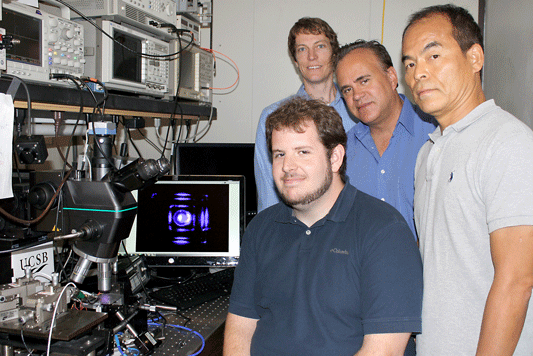- News
23 July 2012
UCSB develops first violet nonpolar vertical-cavity laser
Researchers at University of California, Santa Barbara (UCSB) have developed what is claimed to be the first violet nonpolar vertical-cavity surface-emitting lasers (VCSELs) based on m-plane gallium nitride (GaN).
The latest development is reckoned to open up possibilities for higher-optical-efficiency lasers at greatly reduced manufacturing costs for a variety of applications.

Picture: Shuji Nakamura and his group at UCSB demonstrate the first nonpolar m-plane GaN VCSEL. From left to right: Casey Holder, Daniel Feezell (back), Steven DenBaars, Shuji Nakamura. Credit: UCSB College of Engineering.
“We have demonstrated working, electrically injected nonpolar m-plane nitride VCSELs lasing at room temperature, and have shown that such devices are naturally polarization-locked along the crystallographic a-direction of the wurtzite crystal,” says Dr Daniel Feezell, project scientist with Nakamura’s lab. “This is in contrast to the majority of VCSELs, which are typically randomly polarized,” he adds. Feezell directed the research effort with professor Shuji Nakamura and professor Steven DenBaars, co-directors of UCSB’s Solid State Lighting and Energy Center (SSLEC), and graduate student Casey Holder. Their findings have been submitted for publication.
“This is the first report of a nonpolar VCSEL,” claims Nakamura, a professor of Materials at UCSB. “The nonpolar VCSEL has a lot of advantages in comparison with conventional c-plane devices. One major advantage is that the light polarization is locked to one direction,” he adds. “This device could be used for a variety of applications, such as lighting, displays, sensors, and technology that requires energy efficiency and small form-factor.”
VCSELs offer advantages over conventional edge-emitting laser technology for some applications, explains UCSB. On-wafer testing of VCSEL arrays during the manufacturing process, for example, can save costs compared to edge-emitting lasers that require additional steps before they can be tested. Also, VCSELs exhibit low threshold currents, circular and low divergence output beams, and are easily integrated into two-dimensional arrays.
The nonpolar VCSEL platform also provides high optical gain, which helps to increase optical efficiency of devices. “The nonpolar VCSEL could enable new products and applications, such as pico-projectors for smartphones, mobile cinema, or even automotive lighting,” says DenBaars, professor of Materials.
Violet nonpolar VCSELs m-plane GaN
